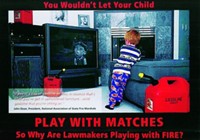Advertisement
Grab your lab coat. Let's get started
Welcome!
Welcome!
Create an account below to get 6 C&EN articles per month, receive newsletters and more - all free.
It seems this is your first time logging in online. Please enter the following information to continue.
As an ACS member you automatically get access to this site. All we need is few more details to create your reading experience.
Not you? Sign in with a different account.
Not you? Sign in with a different account.
ERROR 1
ERROR 1
ERROR 2
ERROR 2
ERROR 2
ERROR 2
ERROR 2
Password and Confirm password must match.
If you have an ACS member number, please enter it here so we can link this account to your membership. (optional)
ERROR 2
ACS values your privacy. By submitting your information, you are gaining access to C&EN and subscribing to our weekly newsletter. We use the information you provide to make your reading experience better, and we will never sell your data to third party members.
Policy
Protecting Consumers
Bills enhance consumer product safety agency's clout
by David J. Hanson
April 28, 2008
| A version of this story appeared in
Volume 86, Issue 17

With growing concerns about lead in paint and phthalates in children's toys, consumers are relying more than ever on the Consumer Product Safety Commission (CPSC) to police unsafe goods. To help CPSC protect the public, Congress is working up legislation that will reform the agency by increasing personnel and providing more resources.
The legislation is not without controversy, however. The Senate and the House of Representatives each recently passed bills to strengthen the battered CPSC. Differences in the two bills must be resolved in an upcoming conference committee, but final approval of legislation this year is likely. In the meantime, fighting over bill provisions, including a possible ban on the use of phthalates in children's toys, is shaping up to be a classic industry versus public interest groups battle.
This congressional action is the result of 2007's series of high-profile nationwide recalls of toys that were not in compliance with CPSC standards, usually because of high lead content. Because many of these products were manufactured in China, the recalls were viewed as evidence of CPSC's inadequacy in monitoring and testing imported goods. Much of the legislation is aimed at improving this situation.
But the overall goal of the legislation is to try to revive an agency suffering from years of abuse. "CPSC needs help," testified agency Commissioner Thomas H. Moore before the House Energy & Commerce Committee's Subcommittee on Commerce, Trade & Consumer Protection last year. "It needs additional resources, more staff, and greater authority to protect consumers from potential hazards."
Even the size of the commission is an issue; one objective of the pending legislation is to restore the agency to its original size of five members. Presently, the commission is authorized to operate with three commissioners but actually has only two members—Moore and Acting Chairwoman Nancy A. Nord—because President George W. Bush has not nominated a third commissioner.
Having only two members is problematic because it is not sufficient for a quorum, and thus, the agency cannot officially conduct business activities such as suing companies, assessing fines, or making new regulations. To address this paralyzing situation, both bills will allow two commissioners to constitute a quorum for nine months after the law is enacted.
Revitalizing the commission also means giving it more staff. Both bills require CPSC to increase its staff from the present 400 people to 500 over the next five years. To pay for this, the legislation authorizes increases in the agency's budget over the next few years from the $80 million appropriated for fiscal 2008 to $88.5 million in 2009 and $156 million by 2015.
In addition to funding more staff, some of the budget increase is to be spent on upgrading the agency's laboratories. The legislation specifies that $40 million in fiscal years 2009 and 2010 will be just for the labs. A CPSC spokesman tells C&EN that the increased funds would be used to build a large, new laboratory for the agency with upgraded equipment and more space for its technical staff.
While agreeing that changes need to be made at CPSC, Nord warned Congress last year that the expansions mandated in the legislation would cost more than has been appropriated. "For example, the requirement for five commissioners will increase the agency's overhead approximately $2 million, monies that could otherwise be spent on enforcement," Nord told the Senate Commerce Committee's Subcommittee on Consumer Affairs, Insurance & Automotive Safety in October. She also said that tougher lead standards included in both bills would require that a lot of resources be diverted from existing enforcement activities in other areas.
The proposed expansion of CPSC, however, is the noncontroversial part of the legislation. A number of other provisions, particularly in the Senate version (S. 2663) of the legislation, have stakeholders up in arms.
One such provision would impose a nationwide ban on the use of six phthalates in all toys and child care products. An amendment to the bill offered by Sen. Dianne Feinstein (D-Calif.) would allow only trace amounts of the compounds di(2-ethylhexyl) phthalate (DEHP), di-n-butyl phthalate (DBP), benzyl butyl phthalate (BBP), diisononyl phthalate (DINP), diisodecyl phthalate (DIDP), and di-n-octyl phthalate (DNOP). Furthermore, under the provision, no substitutes for these compounds could be used if the Environmental Protection Agency identifies the substitutes as carcinogens or chemicals that cause reproductive harm.
Feinstein calls these compounds "dangerous chemicals" and notes that the European Union and the states of California and Washington have already taken similar actions on phthalates in toys.
This is a battle the chemical industry has been fighting for years. In fact, the American Chemistry Council (ACC), which represents 134 of the nation's largest chemical manufacturers, responded to the provision by stating that banning these chemicals won't make products safer.
"Phthalates are among the most thoroughly studied products in the world and have been reviewed by multiple regulatory bodies in the U.S. and Europe," said Sharon Kneiss, ACC vice president of products divisions. "The CPSC review of the safety of phthalates in vinyl toys unequivocally included the statement that there is no demonstrated health risk. After all this study and review, no reliable scientific evidence has found phthalates to cause adverse human health effects."
The House bill (H.R. 4040) does not contain a similar phthalate ban; the controversial provision's survival in the conference committee is doubtful because there are other contentious issues to resolve.
Foremost is the provision in the Senate bill that would allow the attorney general of any state to bring legal actions against a company based on the belief that residents of the state are being adversely threatened by a CPSC violation. Industry's concern is that this gives 50 different attorneys general the power to sue on the basis of how each interprets CPSC regulations.
In a letter to the Senate just before the CPSC reform act was passed, the U.S. Chamber of Commerce (USCC) wrote: "While state attorneys general have an interest in enforcing consumer protection laws enacted by their respective states, effectively deputizing them to enforce federal law in the manner contemplated in S. 2663 is inappropriate. This section would inevitably lead to conflicts between CPSC and states' attorneys general in seeking the best course of action to remedy violations."
Consumer and safety activist organizations, however, see the provision as a way of getting action from various states when the federal CPSC seems unable to move. "CPSC does not have the capacity to enforce recalls in every store and every city across the country. In order to protect children from unsafe toys and children's products, it makes sense to have 50 additional cops on the beat," wrote a coalition of consumer organizations.
If companies are found in violation of the laws, the legislation would also significantly increase the penalties that must be paid. For criminal violations, fines are increased fivefold from a maximum $50,000 fine and one year in jail to a $250,000 fine and up to five years in jail. In addition, the legislation requires forfeiture of any assets from sale of illegal products. For civil penalties, the maximum fine would increase from $1.8 million to $20 million. Even though Congress hopes that the tougher penalties will serve as a strong incentive for companies to avoid violating CPSC rules, some industry observers see the high fines potentially driving smaller companies out of business and decreasing a company's willingness to cooperate with CPSC.
Another disputed provision in the legislation would require CPSC to establish a searchable database on its website including all reports it receives of injury, death, or risk of injury from a consumer product. Such reports could come from consumers, other government agencies, health care providers, or public safety organizations. CPSC would have to post reports within 15 days of receiving them. The agency would also then be obligated to investigate the claims and to remove any report found to be incorrect.
USCC has serious problems with this provision. "The bill's requirement for CPSC to create a public database without any safeguards or assurances that the information posted is true and accurate will lead to consumer confusion and give rise to lawsuits based on rumor repeated through the echo chamber of the Internet," it said in its letter to the Senate. USCC adds that if CPSC posts something in the database that is in error, it could cause tremendous harm to a company that may have done nothing wrong.
But consumer organizations see it as empowerment for the consumer. The database would allow CPSC to do its most important job, they claim, which is providing consumers with access to product information without the formality of regulations or litigation.
The Senate bill also would provide significant protection to company employees who report product safety problems. If a company is found to have retaliated against a whistle-blower, it could be fined up to $250,000 and have to pay compensatory damages. This extension of protections to company employees is viewed as an important measure by consumer organizations and is expected to encourage reporting of unsafe products.
Business groups, however, see the potential for abuse of this measure. "This provision would allow a disgruntled employee a powerful incentive to report preliminary, erroneous, or unsubstantiated information as an alleged product safety violation in order to insulate themselves from disciplinary action for reasons entirely unrelated to product safety," USCC cautioned.
Because of the contentious provisions in the Senate bill, the Bush Administration strongly opposes the legislation, but a letter from the Office of Management & Budget did not say whether the President would veto the measure.
The House and Senate are expected to reach a compromise on the legislation before the Memorial Day recess. The resulting legislation would significantly change the relationship between CPSC and industry by creating an agency that relies more on high penalties and tough enforcement and less on the mutual cooperation of the past. The test is whether this will be more effective for protecting consumers.






Join the conversation
Contact the reporter
Submit a Letter to the Editor for publication
Engage with us on Twitter